

Open Access Countries and Organisations - africa. Gestió del coneixement » Noves professions per a l’individu connectat. Maîtrise / maître d’oeuvre / maître d’ouvrage. Organisation apprenante. Un article de Wikipédia, l'encyclopédie libre.
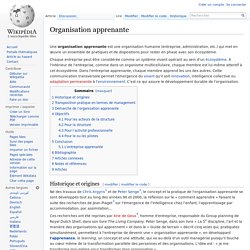
Une organisation apprenante est une organisation humaine (entreprise, administration, etc.) qui met en œuvre un ensemble de pratiques et de dispositions pour rester en phase avec son écosystème. Chaque entreprise peut être considérée comme un système vivant opérant au sein d'un écosystème. À l'intérieur de l'entreprise, comme dans un organisme multicellulaire, chaque membre est lui-même attentif à cet écosystème.
Dans l'entreprise apprenante, chaque membre apprend les uns des autres. Cette communication transversale permet l'émergence du vivant qu'il soit innovation, intelligence collective ou adaptation permanente à l'environnement. Configuration management. Top level Configuration Management Activity model Configuration management (CM) is a systems engineering process for establishing and maintaining consistency of a product's performance, functional and physical attributes with its requirements, design and operational information throughout its life.[1][2] The CM process is widely used by military engineering organizations to manage complex systems, such as weapon systems, vehicles, and information systems.

Outside the military, the CM process is also used with IT service management as defined by ITIL, resp. ISO/IEC 20000, and with other domain models in the civil engineering and other industrial engineering segments such as roads, bridges, canals, dams, and buildings.[3][4][5] Introduction[edit] CM, when applied over the life cycle of a system, provides visibility and control of its performance, functional and physical attributes. Metalearning and Other Ghastly Sounding Words. Metalearning in teamsWikipedia makes a distinction when metalearning is used in the context of performances of teams and relationships: on first reading, you’re a genius!

Having spent half an hour at least, thinking and researching the meanings behind these words and phrases, I found they took me back to a topic I’ve revisited several times on this blog in the last year. Critical systems thinking. Critical systems thinking is a systems thinking framework, that wants to bring unity to the diversity of different systems approaches and advises managers how best to use them.[1] Critical Systems Thinking according to Bammer (2003) "aims to combine systems thinking and participatory methods to address the challenges of problems characterised by large scale, complexity, uncertainty, impermanence, and imperfection.

It allows nonlinear relationships, feedback loops, hierarchies, emergent properties and so on to be taken into account and Critical Systems Thinking has particularly problematised the issue of boundaries and their consequences for inclusion, exclusion and marginalisation".[2] See also[edit] Quels indicateurs pour la gestion des talents ? Publié le 03/11/2010 Attention, cet article a été publié le 03/11/2010.
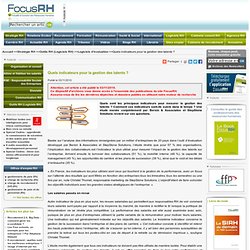
Joseph Schumpeter. Joseph Alois Schumpeter (German: [ˈʃʊmpeːtɐ]; 8 February 1883 – 8 January 1950)[1] was an Austrian-born American economist and political scientist.

He briefly served as Finance Minister of Austria in 1919. In 1932 he became a professor at Harvard University where he remained until the end of his career. One of the most influential economists of the 20th century, Schumpeter popularized the term "creative destruction" in economics.[2] Knowledge intensive business services.
Strategic information system. Strategic information systems are information systems that are developed in response to corporate business initiative.
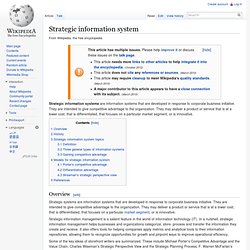
They are intended to give competitive advantage to the organization. They may deliver a product or service that is at a lower cost, that is differentiated, that focuses on a particular market segment, or is innovative. Overview[edit] Strategic systems are information systems that are developed in response to corporate business initiative. They are intended to give competitive advantage to the organization. Gestion électronique des documents.
Un article de Wikipédia, l'encyclopédie libre.

Pour les articles homonymes, voir GED. Business process reengineering. Business Process Reengineering Cycle Business process re-engineering is a business management strategy, originally pioneered in the early 1990s, focusing on the analysis and design of workflows and business processes within an organization.
BPR aimed to help organizations fundamentally rethink how they do their work in order to dramatically improve customer service, cut operational costs, and become world-class competitors.[1] In the mid-1990s, as many as 60% of the Fortune 500 companies claimed to either have initiated reengineering efforts, or to have plans to do so.[2] BPR seeks to help companies radically restructure their organizations by focusing on the ground-up design of their business processes.
According to Davenport (1990) a business process is a set of logically related tasks performed to achieve a defined business outcome. Business process re-engineering is also known as business process redesign, business transformation, or business process change management. PolicyPitch. IJCSN Journal is an International Journal of Computer Science and Network (IJCSN) is an open source online peer reviewed computer science journal launched by D-LAR Labs (Digital Library of Academic Research) publisher that publishes Review/Research articles which contribute new theoretical results in all areas of Computer Science, Communication Network and Information Technologies.
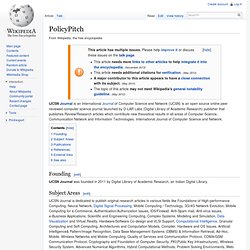
International Journal of Computer Science and Network. Founding[edit] IJCSN Journal was founded in 2011 by Digital Library of Academic Research, an Indian Digital Library. Knowledge policy. Policies are the paradigms of government and all bureaucracies.
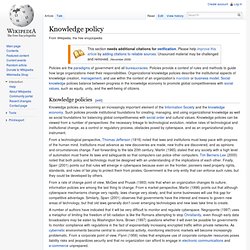
Policies provide a context of rules and methods to guide how large organizations meet their responsibilities. Organizational knowledge policies describe the institutional aspects of knowledge creation, management, and use within the context of an organization’s mandate or business model. eRulemaking. Electronic rulemaking (also known as eRulemaking and e-rulemaking) is the use of digital technologies by government agencies in the rulemaking and decision making processes. An interdisciplinary electronic rulemaking research community has formed as a result of National Science Foundation funding under the auspices of the Digital Government Program.
Groups such as the Cornell E-Rulemaking Initiative (CeRI) have been focused on researching how technologies such as Web 2.0 can help foster greater public participation in the political process, specifically, in Federal Agencies’ rulemaking. Background[edit] In the United States, Electronic rulemaking (also known as eRulemaking and e-rulemaking) can be understood as a subset of a larger Federal eGovernment initiative.
President George W. Since 2008, President Barack Obama has greatly increased the number of Federal eGovernment initiatives.[2] Semantic Interoperability Centre Europe. The Semantic Interoperability Centre Europe (SEMIC.EU) was an eGovernment service initiated by the European Commission and managed by the Interoperable Delivery of European eGovernment Services to public Administrations, Businesses and Citizens (IDABC) Unit. As one of the 'horizontal measures' of the IDABC, it was established as a permanent implementation of the principles stipulated in the 'European Interoperability Framework' (EIF).
It offered a service for the exchange of semantic interoperability solutions, with a focus on demands of eGovernment in Europe. Through the establishment of a single sharing and collaboration point, the European Union wanted to resolve the problems of semantic interoperability amongst the EU member states. The main idea behind the service was to make visible specifications that already exist, so as to increase their reuse. In December 2011, the content and the activities of SEMIC.eu was migrated to a new collaborative platform: Joinup. E-Government. Transformational Government. Transformational Government is the use of computer-based information and communications technologies (ICT) to enable radical improvement to the delivery of public services. The term is commonly used to describe a government reform strategy which aims to avoid the limitations which have come to be seen as associated with a traditional e-Government strategy.
Government transformation programs involve a shift in emphasis, away from silo-based delivery and towards an integrated, multi-channel, cross-platform, self-service delivery approach: an approach which enables a whole-of-government view of the customer and an ability to deliver services to citizens and businesses where and when they need it most, including through one-stop services and through private and voluntary sector intermediaries. History[edit] During the last two decades, governments around the world have invested in ICT with the aim of increasing the quality and decreasing the cost of public services.
National innovation system. The National Innovation System (also NIS, National System of Innovation) is the flow of technology and information among people, enterprises and institutions which is key to the innovative process on the national level. According to innovation system theory, innovation and technology development are results of a complex set of relationships among actors in the system, which includes enterprises, universities and government research institutes. Knowledge economy. The knowledge economy is the use of knowledge (savoir, savoir-faire, savoir-etre) to generate tangible and intangible values. Technology and in particular knowledge technology (Artificial Intelligence) help to transform a part of human knowledge to machines.
This knowledge can be used by decision support systems in various fields and generate economic values. Knowledge economy is also possible without technology.[1] The phrase was popularized by Peter Drucker as the title of Chapter 12 in his book The Age of Discontinuity, And, with a footnote in the text, Drucker attributes the phrase to economist Fritz Machlup and its origins to the idea of "scientific management" developed by Frederick Winslow Taylor.[2]
Framework for pmgt.Pdf. The Nature of Entrepreneurial Opportunities: Understanding the Process Using the 4I Organizational Learning Framework - Dutta - 2005 - Entrepreneurship Theory and Practice. Machine à vecteurs de support. Un article de Wikipédia, l'encyclopédie libre. Les SVM ont été développés dans les années 1990 à partir des considérations théoriques de Vladimir Vapnik sur le développement d'une théorie statistique de l'apprentissage : la Théorie de Vapnik-Chervonenkis. Les SVM ont rapidement été adoptés pour leur capacité à travailler avec des données de grandes dimensions, le faible nombre d'hyper paramètres, leurs garanties théoriques, et leurs bons résultats en pratique. Apprentissage supervisé. Un article de Wikipédia, l'encyclopédie libre. L'apprentissage supervisé est une technique d'apprentissage automatique où l'on cherche à produire automatiquement des règles à partir d'une base de données d'apprentissage contenant des « exemples » (en général des cas déjà traités et validés).
Algorithmic learning theory. Genetic algorithm. The 2006 NASA ST5 spacecraft antenna. This complicated shape was found by an evolutionary computer design program to create the best radiation pattern. Genetic optimization method. Principaux projets et réalisations en intelligence artificielle. Un article de Wikipédia, l'encyclopédie libre. Cette liste indique les principaux projets et réalisations marquants dans le domaine de l’intelligence artificielle. La quasi-totalité de ces travaux ont été accomplis aux États-Unis, et il est à noter que nombre d’entre eux ont été financés par l’armée américaine.
Applying machine learning or bio-inspired learning techniques to communication networks: Firestation. <p class="box warning">JavaScript is disabled in your browser. Please enable to use all features of this website. </p> FIRE News subscription. Authoring system. Knowledge manager. Competency management system. International Centre for Decision Sciences & Forecasting (CDSF)
ALIVE » Augmented Learning Lecture. Gestion des connaissances. Machine learning. Seven Aspects of Strategy Formation.